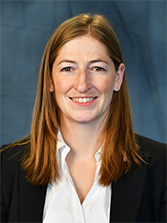Seminars
Dr. Abigail Hunter
Computational Physics Division
Los Alamos National Laboratory
Mesoscale Investigation of Dislocation-Grain Boundary Interactions in Metals and Alloys

ABSTRACT: “Microstructure” refers to the large number of crystal grains and their corresponding boundaries that make up metals and alloys. A material’s ability to accommodate stress induced through mechanical loads is dependent on the ease with which dislocations can move through the microstructure to relieve accumulated stress. Grain boundaries (GBs) are the largest impediment to this motion – this is true to some extent regardless of the grain size. The GB structure defines whether a dislocation can transmit across a GB, be partially absorbed at the GB, or glide along the GB and re-emit, altering the GB structure. For poor alignment between grains, dislocations can pile-up against GBs, building localized internal stress regions that work harden the material. This preferential localization of strains and plastic deformation at specific microstructural sites are precursors to damage nucleation. Thus, understanding and predicting dislocation-grain boundary interactions are key for capturing mechanical response, but they are also incredibly complex in part due to the vast number of possible grain boundaries and corresponding dislocation interactions. This talk will focus on recent multiscale modeling efforts addressing dislocation-grain boundary interactions. Connections to both experimental and atomistic efforts will also be discussed, along with methods/approaches that can be used to scale information.
BIOGRAPHY: Dr. Abigail Hunter is currently the group leader for the Materials and Physical Data Group (XCP-5) at Los Alamos National Laboratory (LANL) in the Computational Physics (XCP) Division. She earned a Ph.D. in Mechanical Engineering from Purdue University in 2011 and a B.S. degree in Mechanical Engineering from the University of Utah in 2006. Following her Ph.D., she joined LANL as a postdoctoral research associate in 2011 in the Lagrangian Codes Group (XCP-1) and converted to a staff scientist in 2012. She moved to the Materials and Physical Data Group (XCP-5) in 2019. She is currently the Deputy Director for the Institute of Materials Science at LANL, in addition to acting as an Associate Editor of the Journal of Engineering Materials and Technology. In 2020, she received the Alum of the Year Award from the Department of Mechanical Engineering at the University of Utah in recognition for outstanding achievements in Mechanical Engineering and service to the community. In 2019 she was nationally recognized as a recipient of the Presidential Early Career Award for Scientists and Engineers (PECASE) for work developing and implementing models addressing brittle damage and dislocation dynamics in metals, which are two capabilities designed to address questions concerning advanced manufacturing of new materials. Her research interests include modeling the strength and damage of metals at both the meso- and macro-scales, with specific interest in connections between microstructure, dislocation-based deformation behaviors, and overall material response.